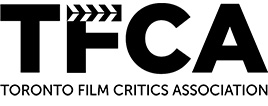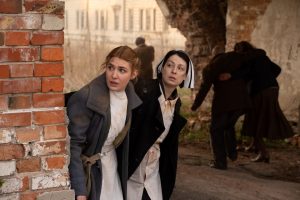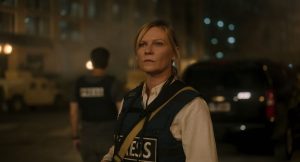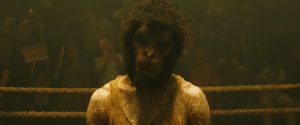Reviews include Irena’s Vow, The Beast, and Before I Change My Mind.
Music and Lyrics: God Help the Girl and True Stories
October 9, 2014
by Adam Nayman

Some pop songs feel like short films. Take Belle and Sebastian’s 1997 single “Lazy Line Painter Jane,” which, like so many of the Scottish group’s best tracks, penetrates the headspace of an alienated teenager: a girl who “works in the village shop / putting the posters up” and idly plans about the best possible exit strategy. She ends up on “the last bus out of town,” in the company of a potential lover, and while it’s possible that she’s dreaming the whole thing—and that the boy and/or girl she’s hooking up with in the back row is a fantasy projection rather than an actual companion—the details have a documentary clarity. Over the course of six minutes, the song changes from an interior drama into an outbound adventure, and the music swells accordingly; in cinematic terms, it’s as if a slice of handheld cinéma vérité had gradually mutated into a widescreen epic.
With this in mind, it’s not a stretch to see why Stuart Murdoch, a founding member of Belle and Sebastian, has turned to moviemaking. God Help the Girl, the new feature film derived from a musical project Murdoch began in 2004—an album of songs of the same name was released in 2009—was essentially a Belle and Sebastian side project.
Taken together, the tracks on God Help the Girl (the album, two of which found their way onto Belle and Sebastian’s wonderful 2005 disc The Life Pursuit)comprise a loose narrative about post-adolescent trials and travails: roommates, wage slavery, pickups, hookups, and assorted club-land rituals. In 2014, however, the film version attempts to further stitch these slivers of life together into the story of Eve (Emily Browning), an anorexic on the lam from a psychiatric hospital who wants to become a musician, which entails starting a band with a nerdy lifeguard-cum-guitarist (Olly Alexander), who may or may not also be boyfriend material. It’s shot in a painstakingly grainy fashion meant to evoke his group’s album sleeves and littered with pop (and pop-cinema) references that range from the evident (A Hard Day’s Night) to the esoteric (The Umbrellas of Cherbourg).

God Help the Girl isn’t the first movie conceived and directed by a moonlighting guitar-slinger. On Belle and Sebastian’s sophomore album If You’re Feeling Sinister, Murdoch penned a song called “Like Dylan in the Movies,” which cleverly used the title of D.A. Pennebaker’s seminal 1967 documentary as shorthand for the dangers of nostalgia within a relationship—“don’t look back.” But the history of Dylan in the movies includes the former Robert Zimmerman’s directorial debut, Renaldo and Clara (1977), who boasts a running time (four hours) that makes Murdoch’s film look like a music video in comparison. Part concert film, part documentary, part performance art and wholly self-indulgent—Dylan plays “Renaldo” while his wife Sara plays “Clara”—the film is the work of an artist whose ambition, hubris and vanity know no bounds, but as the singer-songwriter in question was already at that point a mythical figure a few years shy of his fortieth birthday, who’s to say how much is too much? Working closely with the great American playwright Sam Shepard, Dylan fashioned a kind of meta-text that in many ways anticipated the genre hybridization and true/false gamesmanship of many subsequent movies, including Todd Haynes’ explicitly Dylanophilic I’m Not There (2007).
A more direct influence on God Help the Girl might be 1986’s True Stories, the lone feature film directed by Talking Heads frontman David Byrne. What Belle and Sebastian were to the UK indie scene of the 1990s, the Heads were to the American pop landscape of the late 1970s and early 1980s, and then some: seguing effortlessly from new wave to post-punk to art-rock to Top 40 to a global beat—sometimes all in the space of a single song—Byrne and his band commanded an audience comprised of taste-makers and everyday record buyers alike. They left a large cinematic footprint as well: in addition to iconic Jonathan Demme concert film Stop Making Sense (1984), the Heads showed up on the soundtrack to Wall Street (1987), which placed their tender, devotional “This Must Be the Place” in juxtaposition to its soulless corporate milieu.
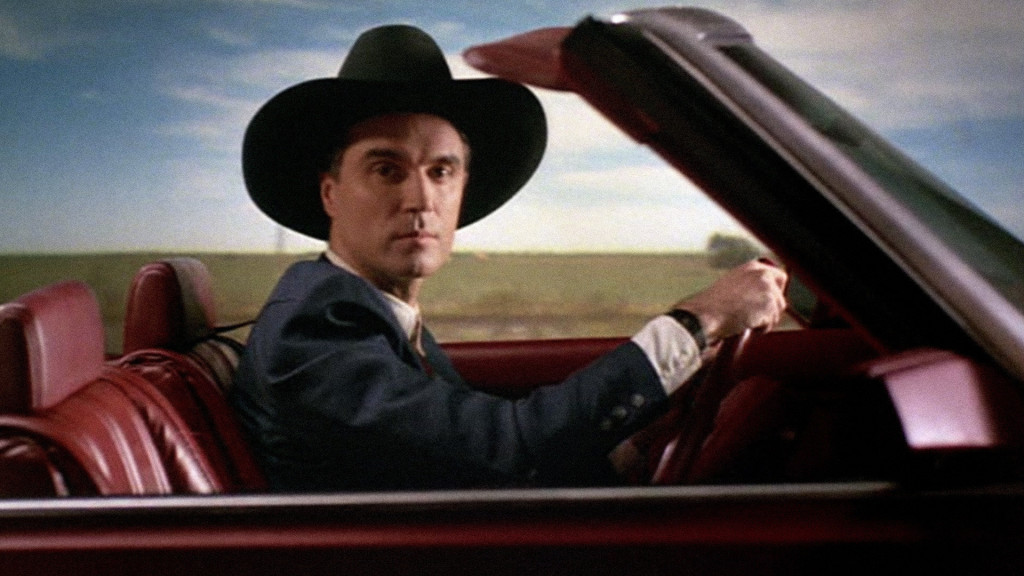
Described by Byrne as being like “60 Minutes on acid,” True Stories presents itself as a documentary portrait of the (fictional) town of Virgil, Texas, with Byrne himself as the nameless investigative journalist dispatched there—quite possibly from Mars. Extending the catatonic-nerd stage persona of Stop Making Sense into a full-on lead performance, Byrne ambles through his own move in cowboy drag, regarding Virgil and its inhabitants with a kind of bemused affection, which mirrors the perspective of the movie itself. Intended as a celebration of small-town values and hospitality as well as a sociological panorama a la Robert Altman’s Nashville—its clearest influence as it builds to a musical performance celebrating the town’s sesquicentennial and independence—True Stories walks a fine line between stylized ethnography and flat-out regional caricature.
What holds the film together is the music. Like God Help the Girl, True Stories is a mixtape musical; most of the vignettes are anchored around songs by the Talking Heads, albeit performed by members of the cast (including John Goodman, who performs the climatic, summative, celebratory “People Like Us”). The first musical number doesn’t take place for almost fifteen minutes, but when it happens, it’s exhilarating—a run-through of the Heads’ infectious “Wild Wild Life” lip-synched at a karaoke bar by the town’s residents, one after the other after the other. It’s at once an image of communal rapture and a tacit admission that the people in True Stories are going to be putting their lips around Byrne’s words—that he’s going to be speaking through them. But there’s another effect being created as well. Coming so soon after Stop Making Sense, where the Talking Heads consolidated their visual image more strongly than any other rock act of the era, the group’s relative invisibility here, combined with Byrne’s ceding the singing to the actors around him, reads as a gesture of self-effacement.
Though poorly received by critics at the time, True Stories holds up in a way that transcends its mid-1980s state-of-the-union address. It’s a period piece whose dated references and presentation don’t dull its sense of urgency. Byrne’s attempt to use his invented Texan hamlet to comment on the changing face of America (at one point a group of kids wander through a suburban subdivision construction site, singing “Hey Now,” with its refrain, “take me to the shopping mall”) represents an artist branching out, and also reaching out; if his reach slightly exceeds his grasp, it’s still easy to appreciate the stretching.
